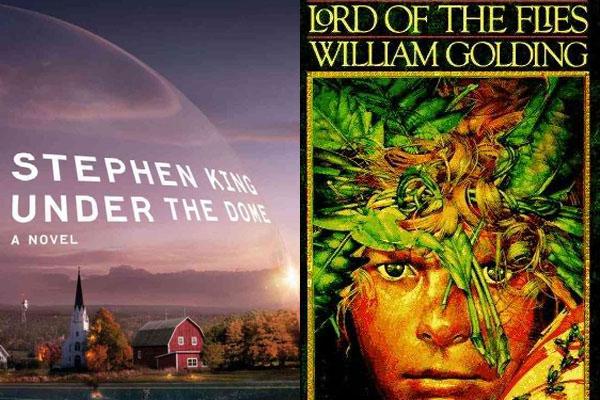Under the Dome? Where have I seen that before?
King’s novel as it relates to Lord of the Flies

King’s novel calls back to the chaos of William Golding’s classic and it’s not a coincidence.
September 17, 2013
Have you ever read a novel and felt as if you were re-reading a story that you’ve already read? Or have you read something in a book that reminded you of something that actually happened? Personally, I had this feeling while reading Under the Dome following finishing Lord of the Flies. Now, William Golding’s bleak allegory Lord of the Flies follows several boys who become trapped on a island during a time of war and little by little give in to their inner savagery because of multiple factors. Several years later Stephen King has written a recently adapted novel called Under the Dome which follows the residents of small town in Maine who become trapped by a giant dome that covers virtually the whole town. These two novels don’t seem to have anything in common upon first glance but there are actually several similarities between the two.
Obviously there are the isolated settings of both books but there are character similarities as well. The villain of Lord of the Flies is Jack Merridew, a boy who fully embraces the loss of civilization and strives to become leader of all the boys on the island. The villain of Under of the Dome is Big Jim Rennie, a used car salesman with delusions of grandeur who likewise makes a bid to take over the entire town. Both villains go mad with power and employ immensely violent henchmen. For Jack, it’s Roger and some of the others boys, while for Big Jim it is his son Junior and the police force, who essentially declare martial law under the leadership of Big Jim. They also use fear of the unknown to better get people under their respective thumbs. Jack uses fear of the supposed beast while Big Jim uses the fear of a possible government conspiracy.
On the opposite side, our heroes are Ralph and Dale “Barbie” Barbara. They are similar in the sense that they seek to get things running smoothly using logical decisions. Helping them with said logical decisions are their wise friends. For Ralph, it’s Piggy and for Barbie it’s Julia Shumway and a few of the wiser members of the town. But sadly they also face numerous challenges from the people around them. Ralph finds himself unable to keep the attention of the boys stranded on the island, who barely help at all with their responsibilities, including keeping the fire that could lead to their rescue alive. Barbie finds trouble since he’s an outsider, being a recently arrived drifter, which makes it easy for people to disregard his warnings about what’s actually going on. And of course, by the end of both novels, everything completely and utterly falls apart.
Another similarity between the two novels is that they are written with heavily political overtones. Golding wrote Lord of The Flies based off of what he saw happen to men during wartime, witnessing firsthand the breakdown of morals that would become key in his novel. One of the themes of Under the Dome is Stephen King’s reaction to the war in Iraq. King considers how the wrong people are in power when we need the right people. According to King, the character of Big Jim represents Cheney in the Bush-Cheney dynamic.
King has previously cited Lord of the Flies as being the book that changed his life, so it should not be that surprising as to how these elements appear in both stories. But I find this brings up the whole question of how previous works influence future works. For example, Star Wars and other works were heavily influenced by the Arthurian legends. So really, how much of a previous story appears in a future story written by an entirely different person? And also how do current issues affect future works? For example, the novel Red Moon by Benjamin Percy is also filled with current issues, using werewolves as allegories for the war on terror, AIDS, and racism.


